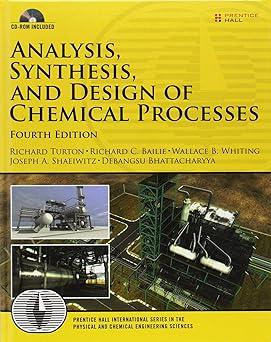Refer to the formalin process in Appendix B. You have recently joined a chemical company. Among the
Question:
Refer to the formalin process in Appendix B.
You have recently joined a chemical company. Among the chemicals that this company produces is methanol, mostly for internal consumption. A major use of internal methanol is to produce formalin, which is a \(37 \mathrm{wt} \%\) solution of formaldehyde in water. Formaldehyde and urea are used to make urea-formaldehyde resins that are subsequently used as adhesives and binders for particleboard and plywood.
The company recently received a memorandum from a customer who buys this formalin indicating that there are periodic problems, mostly in the summer, with the formalin they are receiving. They claim that the formalin contains unacceptably high amounts of formic acid relative to formaldehyde. It seems that this alters the urea-formaldehyde resin properties such that the particle board and plywood subsequently manufactured do not have the appropriate tensile and load strength. They are threatening legal action unless this problem is rectified immediately.
Storage of formaldehyde/water mixtures is tricky. At high temperatures, undesirable polymerization of formaldehyde is inhibited, but formic acid formation is favored. At low temperatures, acid formation is inhibited, but polymerization is favored. There are stabilizers that inhibit polymerization, but they are incompatible with resin formation. Methanol, at concentrations between 5 and \(15 \mathrm{wt} \%\), can also inhibit polymerizaton, but no separation equipment for methanol currently exists on site, and methanol greater than \(1 \mathrm{wt} \%\) also causes defective resin production. With \(\leq 1 \mathrm{wt} \%\) methanol, the storage tank contents must be maintained between \(35^{\circ} \mathrm{C}\) and \(45^{\circ} \mathrm{C}\).
You have toured the plant, checked the logbooks, spoken to engineers and operators, and have gathered the following information:
- The catalyst is replaced once per year, and for about five days after start-up, a pressure-relief valve in the reactor (R-801) releases.
- During the same time period, bfw consumption in R-801 was not seen to increase beyond normal, day-to-day fluctuations of \(\pm 1 \%\), and the reactor outlet temperature was not seen to increase significantly.
- Excess acidity occurs mainly in the summer.
- All existing equipment is made of carbon steel.
- One year ago, an unscheduled, emergency shutdown was required to replace a control system between the tower (T-802) and the subsequent pump (P-803 A/B). Due to availability and time constraints, 1 -in schedule-40 pipe was used in place of 1. 5 -in schedule-40 pipe.
- During hot-weather periods, the inlet temperature of cooling water has been observed to increase by as much as \(5^{\circ} \mathrm{C}\).
- During these hot-weather periods, the pressure in the distillation column has been observed to increase slightly, but operation over a long period of time shows no leakage or safety problems associated with this change in pressure.
- Pump (P-803 A/B) is located at a height of \(5 \mathrm{~m}\) below the tower (T-802) exit. There is a total of 30 equivalent meters of pipe, elbows, and valves in the line.
- An inspection of the pressure-relief valve on the reactor (R-801) indicates that it is rated at \(1115 \mathrm{kPag}\). It will open at or above that pressure.
- Over long periods of time after catalyst replacement, the pressure of medium-pressure steam leaving R-801 is \(1110 \mathrm{kPag}\).
- During hot weather, the volume of off gas leaving the absorber increases by \(1 \%\). However, the increase in formaldehyde is about \(22 \%\), and the increase in water is about \(3 \%\).
- Pump (P-803 A/B) constantly makes noise, and each individual pump has been replaced within the last year. Suggest potential causes for the observed problems, and suggest possible remedies.
Step by Step Answer:

Analysis Synthesis And Design Of Chemical Processes
ISBN: 9780132618120
4th Edition
Authors: Richard Turton, Richard C. Bailie, Wallace B. Whiting, Joseph A. Shaeiwitz, Debangsu Bhattacharyya





